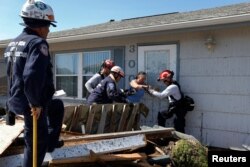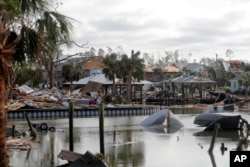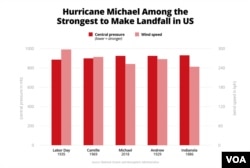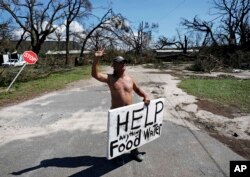The U.S. National Hurricane Center said late Thursday Tropical Storm Michael is moving off the coast of Virginia and into the Atlantic Ocean.
Michael’s “damaging winds and life-threatening flash flooding,” however, are still being felt over portions of North Carolina and the Southern Mid-Atlantic, according to the forecasters.
Michael still has maximum sustained winds of 85 kilometers per hour (52 mph) with higher gusts.
WATCH: Florida Assesses Damage After Hurricane Michael
Earlier Thursday, Michael unleashed strong winds and heavy rain on several southeastern U.S. states after devastating parts of the Florida Panhandle as a major hurricane.
At least six people were reported killed by Michael, the most powerful hurricane on record in that area, and the third strongest to hit the U.S. mainland.
Authorities said the toll was expected to rise, as rescue crews rushed to communities devastated by the storm.
Florida Governor Rick Scott promised a strong relief effort from his administration, speaking one day after then-Hurricane Michael tore into the Panhandle.
"We are going to be aggressive with recovery and response over the coming days and will do everything we can to assist our communities that have seen impacts from this devastating storm," Scott said.
He also called on people in hurricane-hit communities to stay in their homes to give emergency crews room to carry out their work.
Federal Emergency Management Agency Administrator William "Brock" Long, speaking Thursday on CNN, said, "Search and rescue is where we are hyper-focused this morning." Long said Mexico Beach, Florida, "was wiped out" by the storm surge, and efforts were under way to "get the teams in to assess damage."
Long said another priority was to restore power to nearly 800,000 homes and businesses in Florida, Alabama, Georgia and South Carolina.
The National Hurricane Center downgraded Michael to a tropical storm early Thursday, saying its maximum winds had dropped below the threshold for a hurricane.
While the winds eased, the threat of flooding rain, including in areas already soaked by a recent hurricane along the U.S. East Coast, persisted. Forecasters said heavy rains could still produce "life-threatening" flash flooding over parts of the Carolinas and Virginia.
The storm was approaching Greensboro, North Carolina, Thursday afternoon as its tropical force wind gusts and heavy rainfall pounded much of South Carolina and parts of North Carolina. Parts of those states were still recovering from the recent Hurricane Florence.
North Carolina Gov. Roy Cooper said that although Michael was not as devastating as Florence, Michael "adds unwelcome insult to injury."
Michael was expected to maintain a northeasterly track, with its center continuing to move across central and eastern North Carolina on Thursday before moving across southeastern Virginia on Thursday night.
Those states, including northern South Carolina, could receive 10 to 18 centimeters (4 to 7 inches) of rain. The tropical storm was forecast to move into the western Atlantic Ocean Thursday night.
Michael made landfall in the Florida Panhandle with maximum sustained winds of 249 kph (154 mph), putting it just below Category 5 status that tops the scale used to describe the strength and destructive potential of hurricanes.
"We are catching some hell," was how a Panama City Beach resident who decided to ride it out described Michael as it came ashore.
The hurricane downed trees and utility wires throughout Florida Gulf Coast towns, while ripping off roofs and inundating areas with several meters of storm surge.
The Atlantic hurricane season began in June and ends Nov. 30.

















